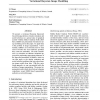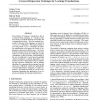76
Voted
ICML
2005
IEEE
16 years 1 months ago
2005
IEEE
We present a variational Bayesian framework for performing inference, density estimation and model selection in a special class of graphical models--Hidden Markov Random Fields (H...
93
Voted
ICML
2005
IEEE
16 years 1 months ago
2005
IEEE
Learning algorithms often obtain relatively low average payoffs in repeated general-sum games between other learning agents due to a focus on myopic best-response and one-shot Nas...
100
click to vote
ICML
2005
IEEE
16 years 1 months ago
2005
IEEE
The problem of learning a transduction, that is a string-to-string mapping, is a common problem arising in natural language processing and computational biology. Previous methods ...
94
Voted
ICML
2005
IEEE
16 years 1 months ago
2005
IEEE
There is a range of potential applications of Machine Learning where it would be more useful to predict the probability distribution for a variable rather than simply the most lik...
126
Voted
ICML
2005
IEEE
16 years 1 months ago
2005
IEEE
This paper explores the issue of recognizing, generalizing and reproducing arbitrary gestures. We aim at extracting a representation that encapsulates only the key aspects of the ...
86
Voted
ICML
2005
IEEE
16 years 1 months ago
2005
IEEE
We investigate using gradient descent methods for learning ranking functions; we propose a simple probabilistic cost function, and we introduce RankNet, an implementation of these...
ICML
2005
IEEE
16 years 1 months ago
2005
IEEE
In many domains, a Bayesian network's topological structure is not known a priori and must be inferred from data. This requires a scoring function to measure how well a propo...
87
Voted
ICML
2005
IEEE
16 years 1 months ago
2005
IEEE
In this paper, we review the paradigm of inductive process modeling, which uses background knowledge about possible component processes to construct quantitative models of dynamic...
110
Voted
ICML
2005
IEEE
16 years 1 months ago
2005
IEEE
In this paper, we propose two new support vector approaches for ordinal regression, which optimize multiple thresholds to define parallel discriminant hyperplanes for the ordinal ...
114
click to vote
ICML
2005
IEEE
16 years 1 months ago
2005
IEEE
Clustering aims to find useful hidden structures in data. In this paper we present a new clustering algorithm that builds upon the consistency method (Zhou, et.al., 2003), a semi-...


